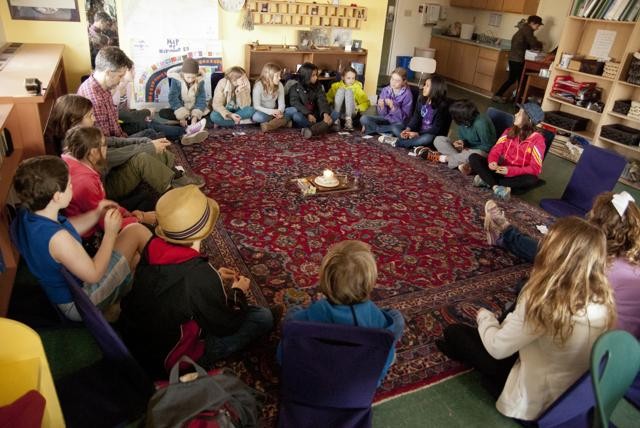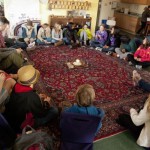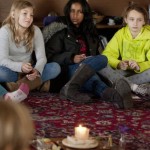- Circle up: Rainbow Mountain Children’s School students gather in a circle each day before class begins to find their center. This morning ritual happens in all grades, from kindergarten through 8th grade. Max Cooper
- Finding their center: Ari Irani, middle, gets ready for daily centering at Rainbow Mountain Children’s School. She says she feels relaxed after doing the 20-minute exercise each day. photos by Max Cooper
Like a conductor, third-grader Daniel lifts his right arm and the chests of his classmates and teachers rise in response. The group sits in a circle on the floor with eyes closed, legs crossed and a candle lit. As Daniel lowers his arm, an echo of exhales keep time. He repeats the movement twice more.
With daily centering complete, another day begins at Rainbow Mountain Children's School.
"This is a time [when] there is not a right or wrong answer," says Executive Director Renee Owen. The centering exercise is about “coming into the present. It's a time to go inward. It's a time to connect with your inner life.”
From kindergarten through eighth grade, students at the West Asheville-based private school do variations on these exercises each morning. But mindfulness for children can be found all over town — such as Mission Children's Hospital and Asheville Pretzel Kids yoga classes.
Imagine that
At Mission Children's Hospital, child-life specialists help children and their families with psychological, developmental and social needs throughout their visit. Sometimes, this can be done with the use of guided imagery, in which a specialist guides patients toward a more relaxed, yet focused state by telling a story, says Tara Horan, child-life specialist manager for Mission Children’s Hospital.
Patients as young as 3 or 4 years old can use guided imagery, says Horan. These young children — sometimes more than adults — possess the most important tool for a successful guided imagery experience. “Kids have imaginations that are very vibrant,” she shares. “So if we can help direct some of those imaginative thoughts in positive direction instead of a scary direction, that's what guided imagery is all about.”
Mission uses the practice before a child undergoes a surgery or medical procedure and when children are dealing with chronic pain, Horan explains. For example, a child-life specialist may ask young patients to visualize a calming setting and instruct them gently when to inhale and exhale.
“Before being the manager of child life, I was working in surgery, and it was wonderful to see kids and families come in with lot of and anxiety fear, work on guided imagery practices, [then] the child march into the OR and have confidence in what was going to happen and then be use these techniques to really relax,” she says.
Horan credits Mission’s Integrative Healthcare Department with bringing the practice into hospital. The department was formed in 2009 and features alternative practices such as aromatherapy, massage and biofeedback,. Despite seeing more interest in alternative services or mindfulness practices, misconceptions linger, Horan says.
“We're not using some psychological trick … We're helping [children] use their own imagination to reduce their stress, anxiety and pain,” she says. “When we explain it in that way, most parents are comfortable letting us try and even get involved [with guided imagery] themselves,” Horan says.
Child-life specialist Andi Nyiradi, trained in children's meditation, says that she tries to help her patients stay in the present moment. “We've done a sensory meditation where the kids can't see what's in the bag. They'll place their hand inside the bag and have to use their sense of touch and really just focus on that one sense,” she explains. “At a really young age, it's really about connecting them with their senses to kind of ground them into the experience into the earth that they're having in the moment.”
Focusing one moment at a time or on one sense at a time, Nyiradi and Horan agree, can be the first step to being mindful in a hyper-connected world.
“I think there's a lot of distractions in our life, and I think it happens even more so for kids now, with handheld devices and stuff like that,” Nyiradi says, adding, “To be able to connect people back to the moment and be present will allow us to open and live … richer and fuller lives for ourselves and each other.”
Child's play
Jane Anne Tager says she tries to help her young yoga students do live richer lives. But as with guided imagery, there can be some uncertainty about what the practice means, she says.
“The word yoga means 'to yolk, or to bring together.' I just say we're learning to bring together our breath, our body and our brain,” she says. In 1998, Tager founded Asheville Pretzel KidsYoga, where she teaches four different yoga classes for children.
“Regarding mindfulness, I don't want people to think that kids sit and ‘Om’ and chant,” says Tager. Freeing the mind is difficult for anyone, she observes. “And [for kids], you just have to kind of honor that. Sitting in stillness is not really realistic.”
Instead, Tager will use sensory experiences, such as smelling herbs or going outside to listen to nature. In one exercise, students sit in a circle and pass cups of water around with intention and, most importantly, without spilling the water. But yoga does not need much modification to be introduced to children, she observes.
“The foundation of yoga is rooted in nature,” Tager explains. “We do animal poses, and they love doing lion pose, which requires a lot of attention because you're rolling your eyes back and putting your body in pouncing position. It's hard to be anywhere else.”
Through teaching yoga, though, she tries her best to be where her students are, saying that they can be the true teachers. “I believe children start out living from their hearts and then society has them start living from their head. I try to be more like them, to live more from my heart,” says Tager.
School of thought
Back at Rainbow Mountain Children's School, Owen explains that living in a hyper-connected, always running, to-do list society is one of the reasons why the school starts each day with 20 to 30 minutes of centering.
“These days, nobody says, ‘Get into the present and see what happens,’” she says. “That transition of going from one place to another can really scatter us. So you come in, the classroom is gently lit, you get into a circle, light a candle and take three breaths. That's really all it takes to go 'I'm in the present. I'm here now. I'm ready to learn.'”
As 10-year-old Ari Irani explains it, “I feel relaxed most of the time [after centering]. It's calming.”
But daily centering goes beyond prepping for the day. Owen says it's about preparing these students for life.
“We want everything for our children. We want them to be able to do whatever they want so they have to be their best self every moment that they possibly can be, and that's one of the things that centering does for them,” says Owen. “They begin the day by going to their best self. … And they can carry that with them for the rest of their lives.”
— Send your health-and-wellness news and tips to Caitlin Byrd at cbyrd@mountainx.com or mxhealth@mountainx.com, or call 251-1333, ext. 140.






One thought on “Kids in mind: Mindfulness practices get kid-sized”